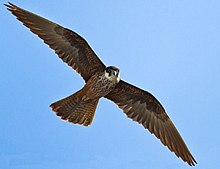Falco eleonorae
| Eleonora's falcon | |
|---|---|
 |
|
| Eleonora's falcon | |
| Scientific classification | |
| Kingdom: | Animalia |
| Phylum: | Chordata |
| Class: | Aves |
| Order: | Falconiformes |
| Family: | Falconidae |
| Genus: | Falco |
| Species: | F. eleonorae |
| Binomial name | |
|
Falco eleonorae Gene, 1839 |
|
Eleonora's falcon (Falco eleonorae) is a medium-sized falcon. It belongs to the hobby group, a rather close-knit number of similar falcons often considered a subgenus Hypotriorchis. The sooty falcon is sometimes considered its closest relative, but while they certainly belong to the same lineage, they do not seem to be close sister species. Eleonora's falcon is named after Eleonor of Arborea, national heroine of Sardinia. The genus name falco is from Late Latin falx, falcis, a sickle, referring to the claws of the bird. The species name eleonorae again commemorates Eleonora d’Arborea, who passed a law protecting nesting hawks and falcons.
Eleonora's falcon is an elegant bird of prey, 36–42 cm (14–17 in) long with an 87–104 cm (34–41 in) wingspan. It is shaped like a large Eurasian hobby or a small slender peregrine falcon, with its long pointed wings, long tail and slim body. There are two colour morphs: The adult dark morph is all sooty brown, with black underwing coverts. The light morph is more like a juvenile Eurasian hobby, but has buff underparts, and also shows the contrast between the black underwing coverts and paler base to the flight feathers. Young birds are also like a large juvenile hobby, but the pale underparts contrast with darker wingtips and wing coverts. The call is a typical falcon kek-kek-kek.
This species breeds on islands in the Mediterranean particularly off Greece (where two-thirds of the world's population breeds), but also in Cyprus, the Canary Islands, Ibiza and off Spain, Italy, Croatia, Morocco and Algeria. Tilos Park is the breeding area for 10% of the world population of Eleonora's falcons. Six hundred and fifty pairs of this species breed on this island according to research conducted by the Hellenic Ornithological Society and the European Union LIFE-Nature program of Tilos. It is rare as a vagrant north of its range.
...
Wikipedia

